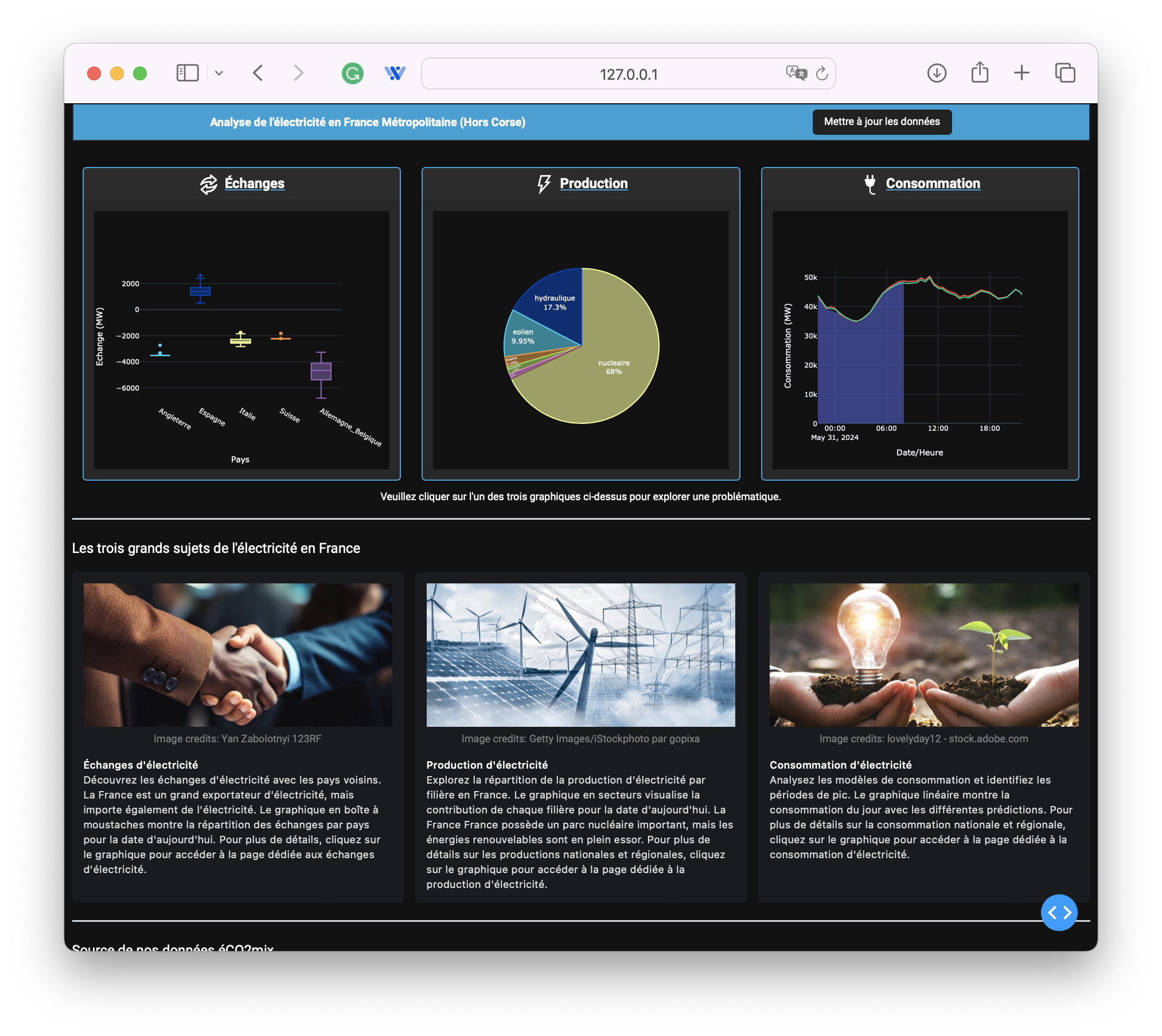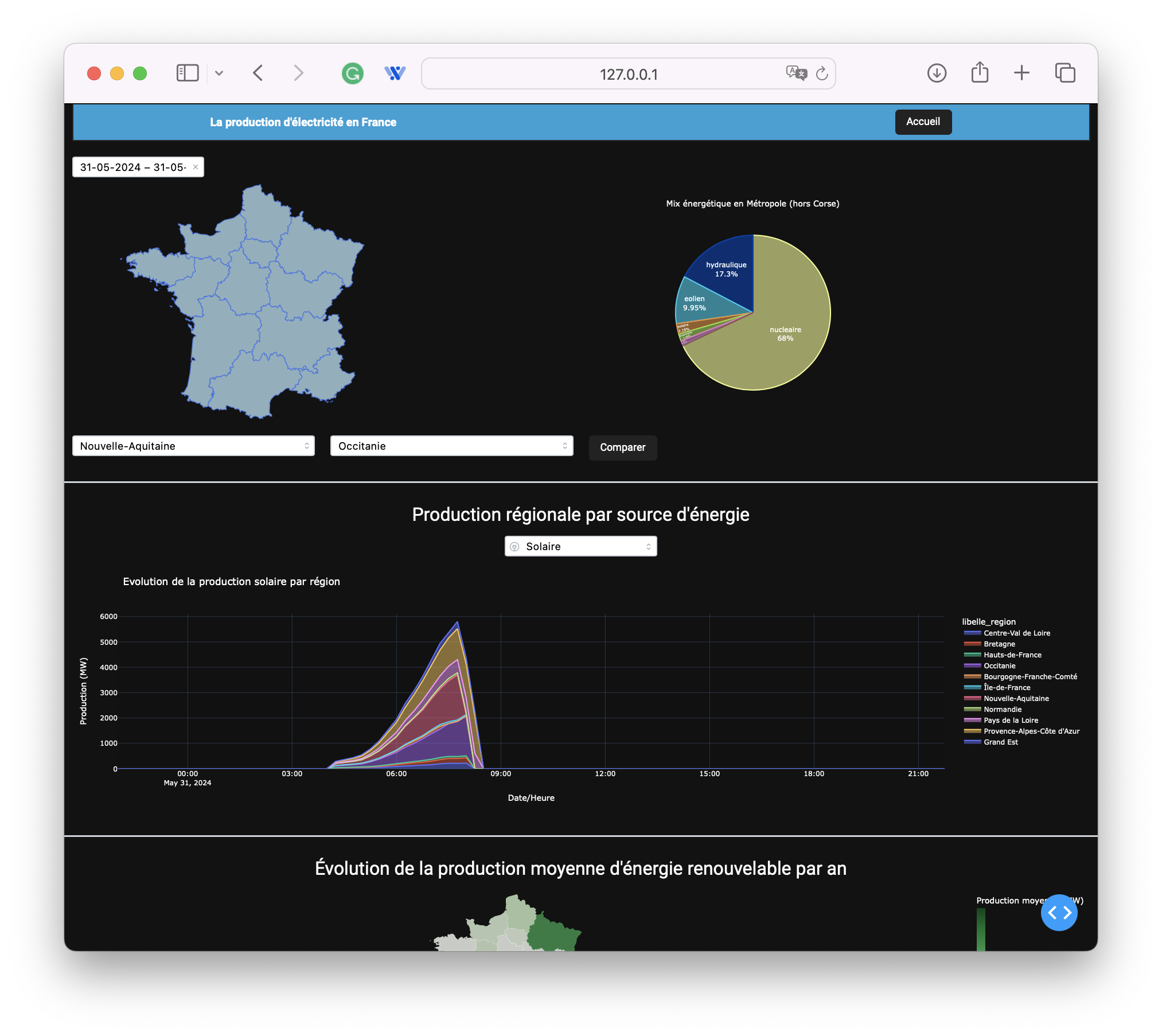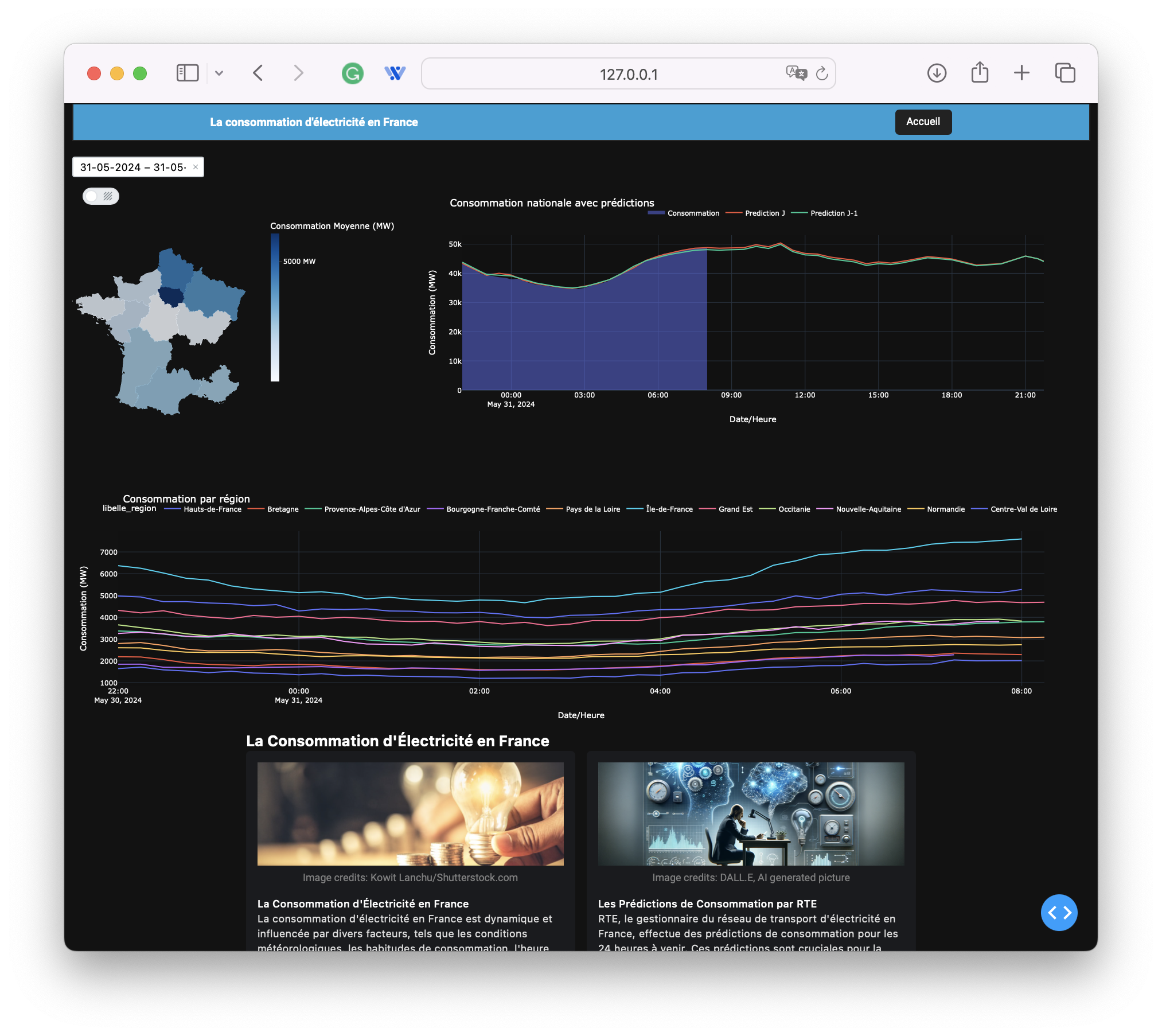Analytical Visualization Project
Interactive visualizations of large quantities of energy data.
Interactive Visualizations of Large Energy Data with Dash and MongoDB
Introduction
As part of the analytical visualization course, we completed a project to visualize energy data from metropolitan France. We used the Dash framework to create a web application that allows interactive visualization of energy data from metropolitan France.
GitHub Repository:
Objective
The goal of this project is to develop a web application that allows for interactive visualization of energy data from metropolitan France.
Data Overview
éCO2mix is a tool created by RTE France to better understand electricity in metropolitan France (excluding Corsica) in real-time. RTE France provides free access to the databases used by éCO2mix through the Opendatasoft platform, offering data from 2013 to the present. The information provided by these databases includes:
- Electricity consumption in metropolitan France (excluding Corsica) and forecasts calculated the day before and in the afternoon of the current day;
- French electricity production by energy source, in value and percentage;
- Electricity trade with the 6 neighboring countries;
- CO2 emissions generated by electricity production;
- Monthly data on a regional scale: consumption, production, and interregional flows.
We used energy data from metropolitan France provided by the OpenDataSoft platform. This data is available in real-time and as consolidated data. We used both real-time and consolidated data to build our application.
Database
MongoDB Database
We used a MongoDB database to store the energy data for metropolitan France. We created a database named “eco2mix” containing 2 collections: “national” and “regional.” The “national” collection contains real-time and consolidated national data, while the “regional” collection holds real-time and consolidated regional data. We used the pymongo library to interact with the MongoDB database.
Here is a schema of the database:
graph TB
subgraph Energy
subgraph "Regional Data"
A1[Date]
A2[Time]
A3[Region]
A4[Consumption]
A5[Production by sources]
end
subgraph "National Data"
B1[Date]
B2[Time]
B3[Consumption]
B4[Consumption forecasts]
B5[Production by sources]
B6[CO2 Emissions]
B7[Imports and Exports]
end
end
Advantages of MongoDB for Storing Energy Data
We chose MongoDB to store the energy data for our project due to its numerous advantages, which are particularly suited to the requirements of a real-time data visualization application.
1. Schema Flexibility: MongoDB allows managing semi-structured data, making it ideal for easily integrating different sources of energy data (national and regional) while allowing for adjustments over time without restructuring the database.
2. Real-Time Performance: MongoDB is optimized for fast read and write operations, which is crucial for our application where energy data is updated in real time and needs to be immediately available for visualization.
3. Horizontal Scalability: With its sharding capabilities, MongoDB allows data to be distributed across multiple servers, ensuring efficient scalability to handle the increasing amount of energy data over time.
4. Easy Integration with Python: MongoDB’s native integration with Python, through the pymongo library, simplifies data access and manipulation, making development smoother and data interaction more intuitive.
5. JSON Document Support: MongoDB stores data in BSON (Binary JSON), facilitating its use with modern web applications and frameworks such as Dash, which rely on the JSON format for data transmission.
These characteristics make MongoDB an ideal solution for our project, providing a combination of flexibility, performance, and security, well-suited to the needs of a real-time interactive visualization application.
Dash Framework
What is Dash?
Dash is an open-source framework developed by Plotly that allows the creation of interactive web applications using Python. Dash is built on Flask, Plotly.js, and React.js, making it a powerful framework for creating interactive web applications. Dash allows the creation of interactive dashboards, charts, maps, diagrams, tables, and more, all using only Python code.
We chose Dash to build our web application for energy data visualization for several reasons:
- Ease of Use: Dash enables creating interactive web applications in Python without requiring knowledge of HTML, CSS, or JavaScript.
- Interactivity: Dash provides advanced features to make charts and dashboards interactive, which is essential for our application.
- Integration with Plotly: Dash is based on Plotly, a powerful online data visualization library, which allows us to create high-quality charts.
- Flexibility: Dash offers great flexibility to customize the appearance and behavior of the web application, allowing us to create a user interface tailored to our needs.
Dash Callbacks
Dash callbacks are a key element of the interactivity in our web application. Callbacks allow updating charts, tables, and other user interface elements based on user interactions. For example, we created dropdowns that allow users to select a specific region or date, and the charts update in real time based on the user’s selection.
Here is an example of a Dash callback:
1
2
3
4
5
6
7
8
9
10
11
12
13
14
import view.figures as figures
from dash import callback, Output, Input
from view.datepicker import default_start_date, default_end_date
@callback(
Output('graph_consommation_by_region', 'figure'),
Input("date-range-picker", "value"),
)
def update_line_chart_consommation_by_region(dates):
if dates is None:
dates = [default_start_date, default_start_date]
return figures.build_line_chart_consommation_by_region(
starting_date=dates[0], ending_date=dates[1])
This callback updates the line chart displaying the electricity consumption by region based on the selected date range in the date picker.
AApplication Architecture
flowchart TD
subgraph API[API]
classDef title size:58px, color:#000
class API title
API1[Real-time national data]
API2[Consolidated national data]
API3[Real-time regional data]
API4[Consolidated regional data]
end
subgraph DataProcessing[Data Processing]
class DataProcessing title
P1[Process Data with Python]
end
subgraph Database[Database]
class Database title
DB[Energy Database]
subgraph Collections
class Collections title
DR[Regional Data]
DN[National Data]
end
end
subgraph DataUpdate[Data Update]
class DataUpdate title
U1[Update Existing Data]
U2[Insert New Data]
end
subgraph DashApp[Dash Web App]
class DashApp title
DWA[Dash App with pymongo]
end
API1 --> |Fetch Data| P1
API2 --> |Fetch Data| P1
API3 --> |Fetch Data| P1
API4 --> |Fetch Data| P1
P1 --> |Process| U1
P1 --> |Process| U2
U1 --> |Update| DR
U1 --> |Update| DN
U2 --> |Insert| DR
U2 --> |Insert| DN
DB --> |Contains| DR
DB --> |Contains| DN
DWA --> |Query & Update| DB
This diagram illustrates the architecture of our application. We used APIs to retrieve energy data from metropolitan France. We then processed this data with Python to store it in a MongoDB database. We created a Dash web application to interactively visualize the energy data stored in the MongoDB database.
Web Application
Application Structure
Our web application is structured into several tabs, each displaying interactive visualizations of energy data from metropolitan France.
Home Page
The first tab is the home page:
This page provides an overview of the three other tabs in the application, which are as follows:
- Electricity Trade: Visualization of electricity trade between France and its neighboring countries.
- Electricity Production: Visualization of electricity production by sector in France, both at the national and regional levels.
- Electricity Consumption: Visualization of electricity consumption in France, both at the national and regional levels.
Electricity Trade
The trade tab displays interactive graphs showing electricity imports and exports between France and its neighboring countries.
Electricity Production
The electricity production tab displays interactive graphs showing electricity production by sector in France, both at the national and regional levels.
Electricity Consumption
The electricity consumption tab displays interactive graphs showing electricity consumption in France, both at the national and regional levels, along with consumption forecasts.
Conclusion
Our web application for visualizing energy data from metropolitan France is a powerful tool for exploring and analyzing real-time energy data. By using Dash, MongoDB, and the éCO2mix APIs, we have created an interactive and intuitive web application that allows dynamic visualization of France’s energy data.




